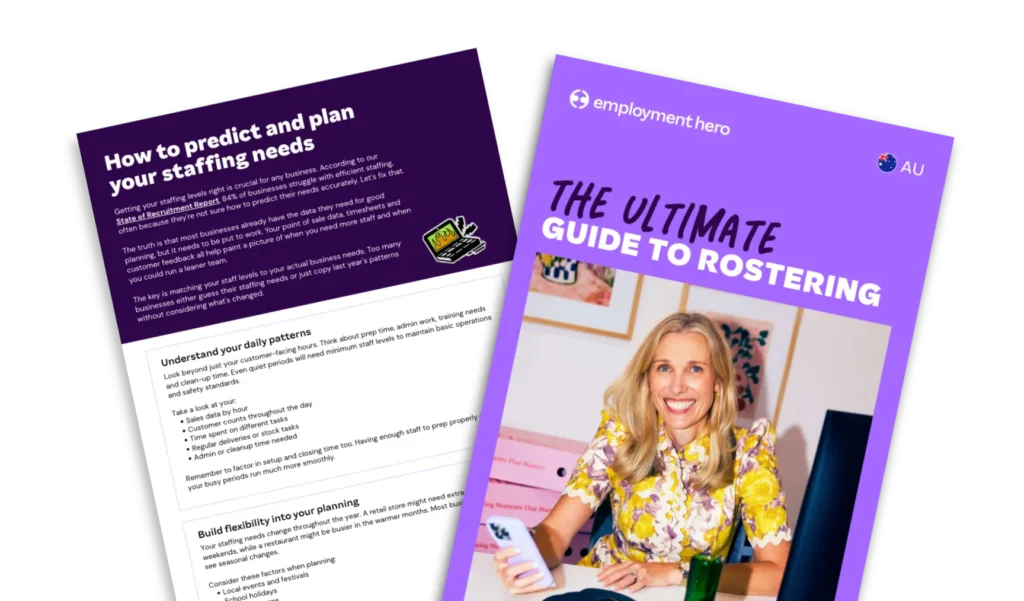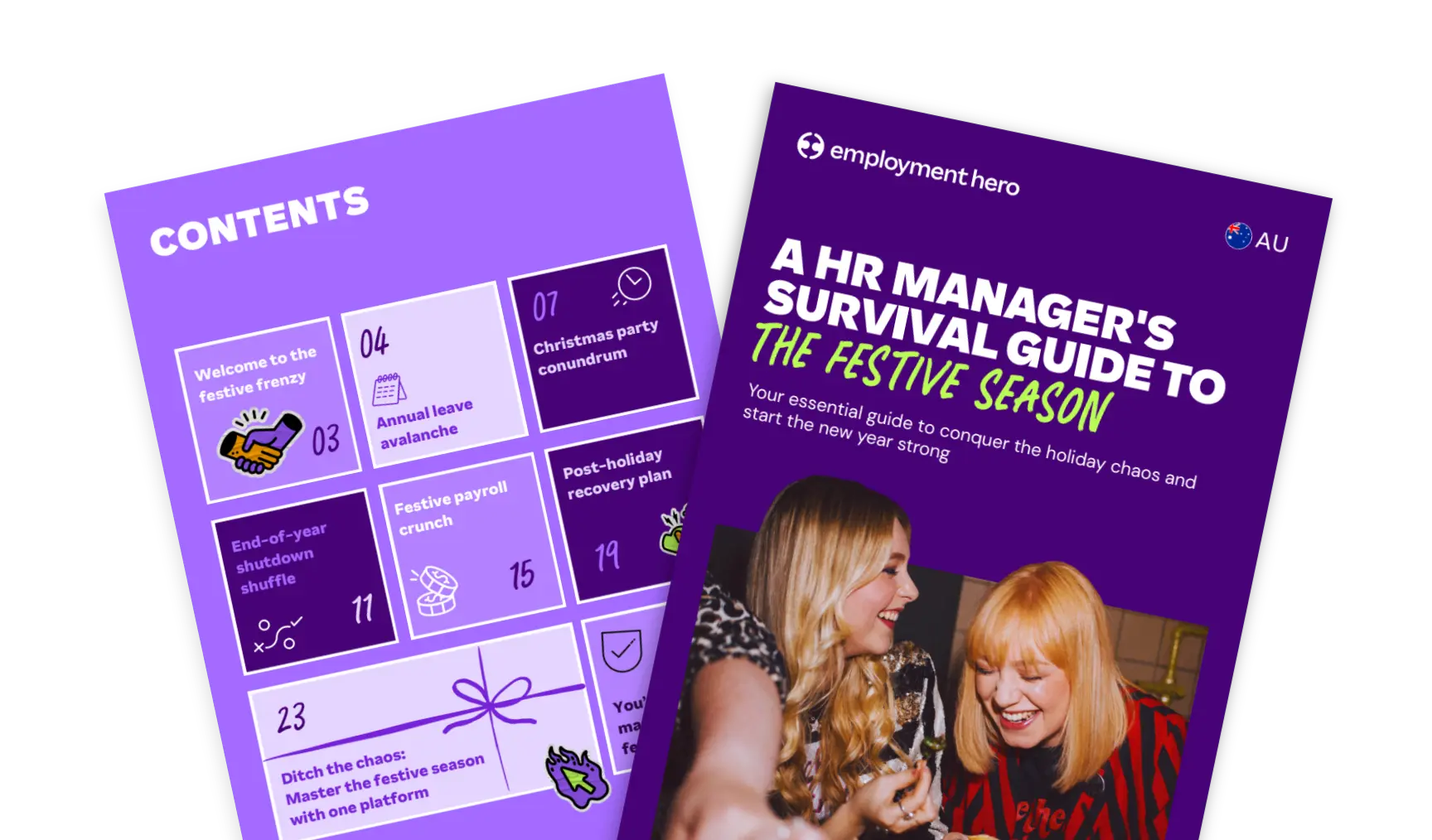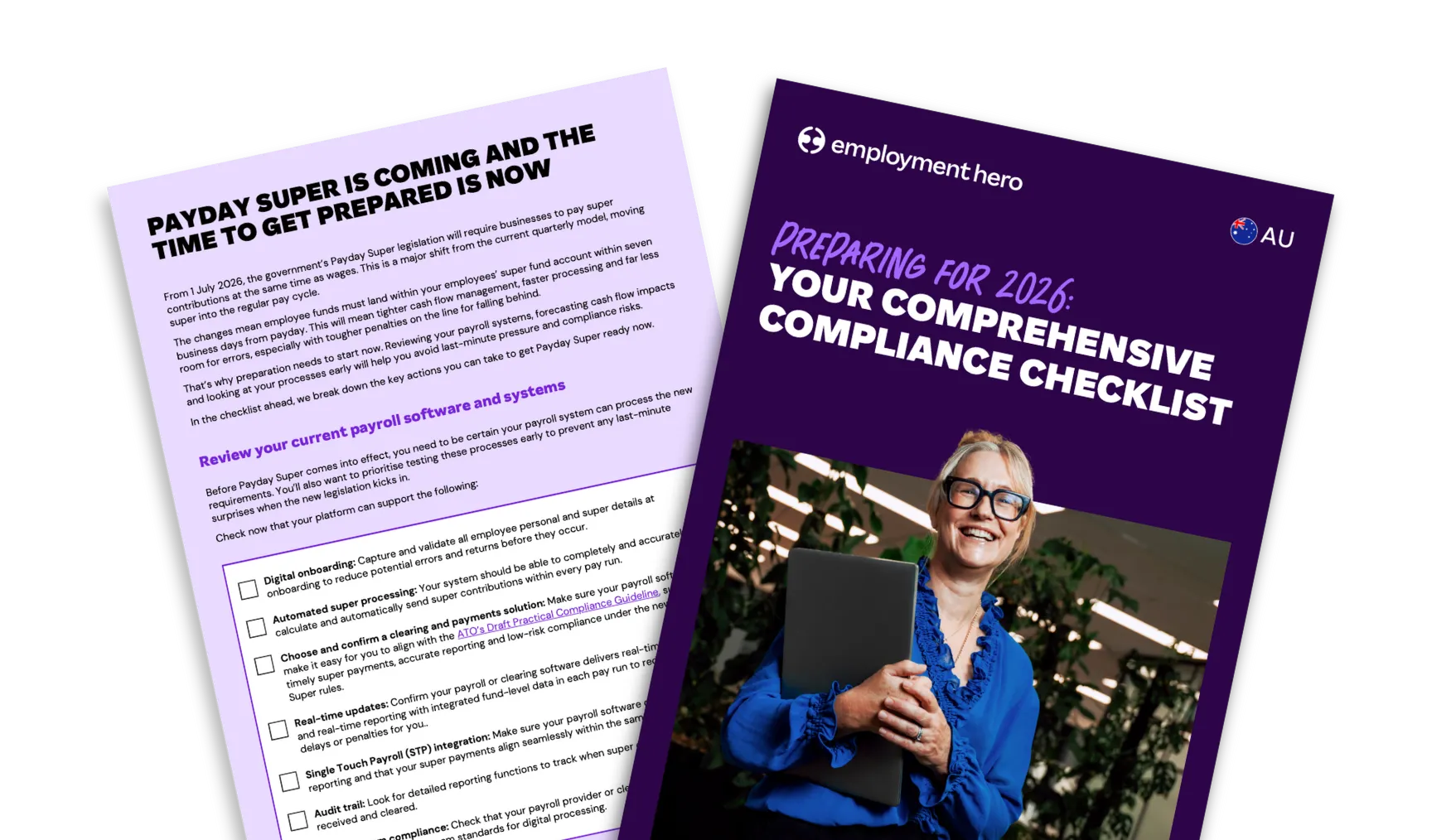The ultimate guide to rostering
Published
The ultimate guide to rostering
Published
Building the perfect staff roster takes more time than you’d probably like to admit. Just when you think you’ve got it sorted, something changes. A staff member calls in sick, there’s a surprise event in town or you realise you’ve forgotten about an upcoming public holiday. And that’s before you’ve double-checked all the modern awards, staff preferences and cost pressures.
An effective roster balances employee needs with operational demands, making sure you have the right people in the right place at the right time. For growing Australian businesses, mastering the staff scheduling process is an important part of controlling costs, maintaining compliance and boosting productivity.
Get it wrong and you risk burnout, high turnover and legal trouble. However, if you get it right, you could unlock a more efficient, engaged and profitable way of running your business.

What’s included in this staff rostering guide?
In our comprehensive staff rostering guide, you’ll find information on:
- Creating an efficient rosters that work for everyone
- Forecasting your labour needs with confidence
- Handling seasonal changes and busy periods
- How to make rostering easier with the right digital tools
Download the guide now by filling in the form on the right hand side.
The benefits of effective rostering
When a roster is created well, it has a direct impact on employee satisfaction, helping your people feel valued, supported and in control of their work-life balance.
Strategic scheduling also ensures you’re using resources efficiently, by reducing unnecessary overtime, avoiding understaffing and keeping labour costs aligned with demand. We’ve outlined the key benefits of effective rostering.
Reducing costs
Smart rostering is one of the most effective ways to manage your labour budget. By aligning staffing requirements with business demand and scheduling appropriate working hours, you minimise costly overtime and reduce the risk of too few staff on shift.
This helps reduce the likelihood of both overstaffing during quiet periods and understaffing during rushes, making sure that every dollar spent on wages directly contributes to your bottom line.
Managing performance and employee growth
While it might not seem like it at first glance, a good roster is a tool for performance management. When you assign shifts thoughtfully, you can pair experienced staff with newer team members for mentoring opportunities.
You can also ensure your top performers are on deck during critical business periods. Consistent staffing and clear schedules allow managers to track progress and performance more effectively, providing the data needed for constructive feedback and development.
Creating a fair roster
Fairness is essential for building a happy team. Unbalanced work schedules, where some employees receive undesirable shifts regularly, while others get preferential treatment, breed resentment and can lead to high turnover.
A well-designed rostering system distributes employee shifts fairly, considering employee preferences and rotating less popular shifts.
Boosting the customer experience
Your roster directly impacts the customer experience. Having the right number of employees with essential skills available makes sure that customers receive prompt and high-quality service.
Effective employee scheduling prevents long wait times, while making sure that specialised roles are always covered. This leads to better customer services, better reviews and repeat business, which are the three core pillars for any growing company.
Improving productivity
Predictability and structure are key drivers of productivity. When employees know their work schedules well in advance, they can plan their personal lives accordingly, leading to a healthy work-life balance and reduced stress.
This stability allows them to arrive focused and ready to perform. A consistent shift schedule also means everyone knows what to expect, as everyone is across their roles and responsibilities well in advance.
Reducing absenteeism
Disorganisation breeds absenteeism, and last-minute employee call-outs put pressure on the rest of the team. A structured employee scheduling process that respects staff availability and provides ample notice for shifts can significantly reduce absenteeism.
When employees feel their time is valued and their work schedules are fair, they’re more motivated and committed. Handling time off requests efficiently can also prevent scheduling conflicts, providing adequate coverage and resource allocation.elps the business avoid costly mistakes and manage psychosocial hazards effectively.

What are the different types of staff rosters?
Choosing the right type of roster depends on your industry, business needs and workforce. Here are some of the main types used in Australian workplaces.
Fixed roster
In a fixed roster, an employee works the same shift (including days and working hours) each week. This model offers maximum predictability for both the employer and the employee, making it ideal for businesses with consistent operational hours, like standard office environments.
Rotating roster
A rotating roster cycles employees through different shifts over a set period. For example, a team might work morning shifts for one week, afternoon shifts the next and night shifts the week after. This is common in 24/7 industries like healthcare and manufacturing to keep fairness in covering all hours.
Split shifts
A split shift divides an employee’s workday into two distinct parts with a significant break in between (e.g. working from 11am to 2pm and again from 6pm to 9pm). This is often used in the hospitality industry to cover peak hours or lunch and dinner services.
On-call rosters
On-call rosters require employees to be available to work if needed, often outside of their regular working hours. This is common for IT support, emergency services and maintenance roles where unpredictable issues can arise.
Flexible rostering options
Modern workplaces are increasingly adopting flexible rostering to attract and retain talent. This can look like compressed workweeks (e.g. a 40-hour week completed in four days), job sharing or allowing employees to input on their shift schedule.
How to roster staff effectively
Creating a great roster is a multi-step process that requires balancing business needs, employee preferences, budget and compliance. Here are our top tips for building an effective roster for your business.
Identify staffing needs based on demand
Start by analysing your business patterns. When are your busiest and quietest times? Use sales data, foot traffic or appointment bookings to forecast demand. This will help you determine how many staff members (and with what skills) you need on deck to keep everything running smoothly without overstaffing.
Factor in employee availability and preferences
It’s important to recognise that your employees have lives, commitments and preferences outside of work. It’s important to acknowledge this by collecting and considering staff availability.
While you can’t accommodate every request, showing that you at least try to accommodate every request can help boost employee morale. An open dialogue about availability and preferences helps prevent scheduling conflicts and makes employees feel valued.
Manage your compliance obligations
Making sure your compliance obligations are fulfilled is non-negotiable when it comes to rostering. You need to make sure modern awards, penalty rates, minimum shift lengths and required breaks are all factored into your rostering process. Getting this wrong can lead to significant financial penalties and legal action, but we’ll cover this in more detail below.
Balance costs and productivity
Your roster should be both productive and cost-effective. Use the demand data you’ve gathered to build a schedule that meets customer needs while staying within your labour budget. Monitor key metrics to find the sweet spot between providing excellent service and managing wage costs. This is where a strategic approach to rostering truly pays off.
Use rostering software to save time and reduce errors
The reality is that manual rostering using a basic Excel staff rostering template or even a Google Docs roster template is time-consuming and can be prone to errors.
Thankfully, there’s no need to rely on these admin-heavy and manual processes anymore. Employee rostering software automates much of this work, helping you assign shifts, manage staff availability, calculate wage costs and manage compliance automatically. This powerful technology (like our Employment Operating System) allows you to streamline scheduling, while giving managers back valuable time to focus on leading their teams.
If you’re using Employment Hero, employees have real power over their schedules. With employee self-service through the EH Work mobile app, your team can easily swap shifts and receive instant updates when important news needs to be shared. No more relying on a manual excel roster template.
The EH Work mobile app gives your team the freedom to:
- View their upcoming shifts anywhere, anytime
- Submit their availability and leave requests
- Swap shifts with qualified team members
- Communicate directly with managers

Rostering and compliance in Australia
In Australia, non-compliance is a serious risk, which can lead to hefty fines, costly back-payment orders and reputational damage. Some key obligations under the Fair Work Act and modern awards you need to be across include:
- Maximum weekly hours: Most awards specify the maximum number of hours an employee can work per week.
- Penalty rates: Most modern awards say you must pay higher rates for work performed on weekends, public holidays, late at night or for overtime.
- Rest breaks: Modern awards mandate paid and unpaid breaks after a certain number of hours worked.
- Record-keeping: You’re legally required to keep accurate records of working hours, pay rates and leave entitlements. Electronic timesheets (or digital timesheets) provide a reliable and auditable way to track hours and simplify payroll.
These are just the start of your compliance obligations you need to be across in the rostering process. Using cloud-based time and attendance tools can help automate these compliance checks, flagging potential issues before they become costly problems.
Common mistakes in staff rostering
Even with the best intentions, it’s easy to make mistakes. Here are some common areas to watch out for:
- Over-or understaffing: Failing to use data to predict demand often leads to having too many or too few staff, hurting either your budget or your customer service.
- Ignoring employee preferences: Consistently ignoring time off requests or availability will damage staff morale and increase turnover.
- Poor communication: Not clearly communicating shift details or changes can lead to confusion and missed shifts. A good system makes sure that updates are sent to everyone instantly.
- Manual errors: Relying on a simple staff rostering template or spreadsheet increases the risk of mistakes in calculating hours or pay, which can lead to compliance breaches. This is where time and attendance software becomes invaluable.
Download the full staff roster guide
Ready to transform your rostering and scheduling process?
Disclaimer: The information in this guide is current as at 20 October 2025, and has been prepared by Employment Hero Pty Ltd (ABN 11 160 047 709) and its related bodies corporate (Employment Hero). The views expressed are general information only, are provided in good faith to assist employers and their employees, and should not be relied on as professional advice. The Information is based on data supplied by third parties. While such data is believed to be accurate, it has not been independently verified and no warranties are given that it is complete, accurate, up to date or fit for the purpose for which it is required. Employment Hero does not accept responsibility for any inaccuracy in such data and is not liable for any loss or damages arising either directly or indirectly as a result of reliance on, use of or inability to use any information provided in this guide. You should undertake your own research and seek professional advice before making any decisions or relying on the information in this guide.
Register for the guide
Related Resources
-
 Read more: HR Managers: Don’t just survive the festive season, master it
Read more: HR Managers: Don’t just survive the festive season, master itHR Managers: Don’t just survive the festive season, master it
Make year-end easier: manage leave, payroll, parties and shutdowns with confidence. Get practical tips for Australian SMEs. Download the free…
-
 Read more: Preparing for 2026: Your Compliance Checklist
Read more: Preparing for 2026: Your Compliance ChecklistPreparing for 2026: Your Compliance Checklist
Get your business ready for the 1 July 2026 changes. See practical steps for Payday Super, cash flow planning and…
-
 Read more: Monthly business budget template for employers
Read more: Monthly business budget template for employersMonthly business budget template for employers
Plan your monthly income and expenses with our free monthly business budget template. Download today to track cash flow and…























